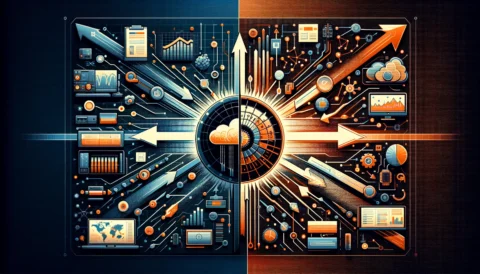Contents
Have you faced issues in remote work during the pandemic?
Are you still trying to streamline the operational efficiency of your business?
Desktop as a Service (DaaS) has been used in the industry for more than a decade now. Through these years, the adoption of DaaS was slow and daunting, as businesses needed time to trust and rely on the cloud.
However, the pandemic has modified this reality. Gartner has recently predicted that the adoption of DaaS will increase by 150% by 2023.
One of the primary reasons behind this shift is setting up remote infrastructure in a cost-effective manner. Many other benefits of DaaS, such as remote working, security, control, backup support, disaster recovery, etc., have encouraged businesses for this implementation.
So, do you think DaaS passed the test in 2021?
Let’s find out,
COVID-19 and Desktop as a Service
Before we evaluate the impact of COVID-19 on DaaS adoption in different industries, let’s first define DaaS:
DaaS is a service that converts end-user PC systems to cloud-hosted virtual desktop. These virtual machines can be provisioned with preferred configuration, which means you can run your application on desired performance level. As end-users of virtual machines, employees need to sign in to the cloud via a browser and a stable internet connection.
What is the impact of COVID-19 on the cloud ecosystem?
DaaS is an age-old idea, which dates back to the 1980s. Back then, the concept of thin clients seemed too modern and risky from a security perspective. In 2021, a crucial driver of sudden DaaS growth is the Coronavirus pandemic.
When the disease first started surfacing back in 2019, many organizations were oblivious of its impact. However, as the virus slowly made its way to countries, states, and cities, workplaces came to a standstill. Without remote working infrastructure, there was no moving forward.
As a result, companies that relied on full-time employees working on dedicated office desktop systems moved to a remote culture. They adopted DaaS and allowed a large section of their employees to work from home securely.
What Does DaaS Bring To The Table?
One critical bottleneck that enterprises often face is ensuring the security of endpoints accessed by employees. Whether employees are using their personal computers or a company’s computer at home, security was a persistent concern.
Desktop-as-a-Service creates a security net over your desktop via a series of implementations, such as multi-factor authentication, internal access control, intrusion detection, and prevention, etc. It means the enterprise can now offer security to their workplace without actually setting up the entire infrastructure on-premise.
DaaS is a creative solution to many such challenges, some of these we have discussed below,
It Is More Than An Alternative
Traditionally, cloud implementation was just an alternative to on-premise VDI setups. Enterprises were using the cloud mainly for backup services or ensuring continuity when on-premise servers faced an issue.
However, more companies are migrating to the cloud completely. They are dismantling on-premise infrastructure and using an efficient and simpler option. This makes sense because a large section of employees working from home and cloud access seems like a hassle-free remote working solution. It relieves the IT staff from maintaining security, ensuring intrusion detection, eliminating unauthorized access, or setting up VPN.
DaaS Is For Every Company
Many small businesses believed that VDI and DaaS implementations are for enterprise-level organizations. This is because using a virtual setup3 for a dozen employees seemed illogical. However, DaaS infrastructure has evolved, and it is suitable for every business.
Here are a few reasons why,
- DaaS is cost-effective. If you are a small organization, you don’t need to spend your budget on hardware and software license purchases. DaaS is a service offered at a pre-decided cost, which is naturally less than VDI or on-premise implementations.
- This infrastructure is perfect for scaling. On the cloud, you can increase and decrease your resources on-demand. The bill in every cycle is adjusted according to your usage. It is beneficial for both small and big businesses.
- DaaS comes with advanced security. Of course, enterprises have a robust security architecture, but having a fully managed and secure service is a blessing in disguise.
DaaS Is Becoming Essential To Businesses
Historically, virtual machines were nice-to-have technology elements in businesses. These additions to the IT infrastructure only enhanced our disaster preparedness. It is also why companies using DaaS before the pandemic didn’t face significant disruptions in the workplace.
The pandemic has been coercing businesses to allow remote work from anywhere anytime. So, DaaS is moving from a nice-to-have element necessary-to-have element.
- As many employees will permanently work from home even after the pandemic, DaaS offers them seamless access and collaboration opportunities. These employees only need a stable internet connection to log in to the server anytime.
- With DaaS, businesses can enable a BYOD policy for employees visiting the office or frequently going on a business trip. This cloud service doesn’t store data or applications on the endpoint. If an employee is using an application, such as QuickBooks, on mobile via the DaaS interface, no sensitive data file will be stored on the employee’s mobile phone.
Benefits of DaaS
While Desktop as a Service has multiple benefits, we have discussed some that add value to your operational efficiency,
- As an employer, you can use refurbished devices or keep using an old device for longer without worrying about the configuration.
- Small businesses can enjoy scaling up and down as required according to organizational needs.
- You can reduce capital expenses on hardware and software licenses. It is easier to set up DaaS over your existing infrastructure.
- The service allows CSP to manage updates and patches in virtual machines automatically.
- It is possible to ensure disaster recovery via backup images stored on redundant servers.
Conclusion: Transformation through DaaS
The pandemic has accelerated adoption for many technology trends in 2020 and 2021. Desktop as a Service is positioned to meet many of these business requirements, from digital transformation to a work-from-home environment. Know more about this model from the above discussion and implement DaaS in your organization.



